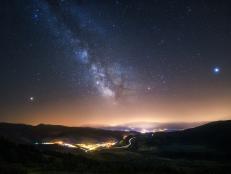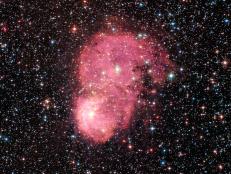All Space Articles
Showing 196 - 210 of 491 results
Following Blue Origin’s NS-12 Rocket Launch
Blue Origin, Billionaire Jeff Bezos’ spaceflight company, is rescheduled to launch its NS-12 reusable spacecraft on Wednesday, December 11. Watch it LIVE.
NASA Astronaut Jeanette Epps Will Make History with Her Next Mission
It was announced this week that Astronaut Jeanette Epps will be added to NASA's Boeing Starliner-1 mission to the international Space Station. She will be the first Black astronaut to live on the ISS.
It's Time for a 2021 Space Flight Round-up
Space is a busy place, with a lot of things going up (most of the time) and coming down (when we want them to). Let’s check in on the latest orbital happenings.
Scientists Have Discovered Enormous Balloon-Like Structures in the Center of Our Galaxy
There's something really, really big in the middle of our Milky Way galaxy — one of the largest structures ever observed in the region, in fact.
The Future of Space Exploration
Over the past couple decades, the space-minded folks around the world have debated the relative merits of the two possible destinations for space exploration. Moon or Mars?
The Secret of Pluto’s Ocean
When we think of an ocean, we don't necessarily think of Pluto. If we can’t see the liquid water, why do astronomers think it’s there?
July in the Sky: Celestial Events Happening This Month
With eclipses, meteor showers, and more, it's a busy month in the night sky this July. Take some time this summer to look up and enjoy these cosmic wonders.
When We’ll Know if NASA’s Asteroid Impact Test was a Success
Recently NASA’s DART mission succeeded in its primary goal, which was to slam a spacecraft face-first into an asteroid. For science. The intention of the mission was to test if we could actually redirect an asteroid and send it into a different orbit. But how and when will we know if it worked?
See Comet NEOWISE Before it Disappears
Discovered in late March, Comet NEOWISE has shown itself in the skies all over the world. Dr. David Schleicher, Senior Astronomer at Lowell Observatory gives us some details about this cool comet gracing the night skies.
Stuck at Home? What to See in the Night Sky this Month
In times of darkness and incertainty, opt for exploration of wonder in the skies.
Astronomy’s Newest Tool: Artificial Intelligence
In a bowl, combine a tablespoon of hydrogen and a teaspoon of helium to a cup of dark matter. Add a pinch of neutrinos and sprinkling of radiation. Mix well to combine. Heat to several million Kelvin. When mixture has risen, leave to cool for 13 billion years.
Celebrating Hubble's 30 Year Legacy
Three cheers for the Hubble! First launched in 1990 aboard the Space Shuttle Discovery, the storied space telescope is celebrating is thirtieth year in lonely orbit around the Earth.
The Milky Way Broke its Arm (But is Totally Okay)
The Milky Way is a giant, magnificent, truly transcendently beautiful spiral arm galaxy. It’s too bad we can’t get a decent picture of it. The problem is that we live inside it, and so astronomers have to work extra-hard to construct an accurate map.
The Wow Signal: No, It Wasn’t Aliens
On a typical muggy midwestern August evening in 1977, astronomers at the Ohio State University’s Big Ear radio telescope got a big surprise. It was a signal so loud that it could only be described with one word: “wow!”
That’s a (Weirdly) Big Black Hole!
Recently astronomers identified a black hole near a star called LB-1 and they found out that the black hole is 70 times the mass of the sun. This is a mystery because the biggest black holes we can get from the deaths of the most massive stars are around 30 times the mass of the sun, so how did black hole get this big?


























